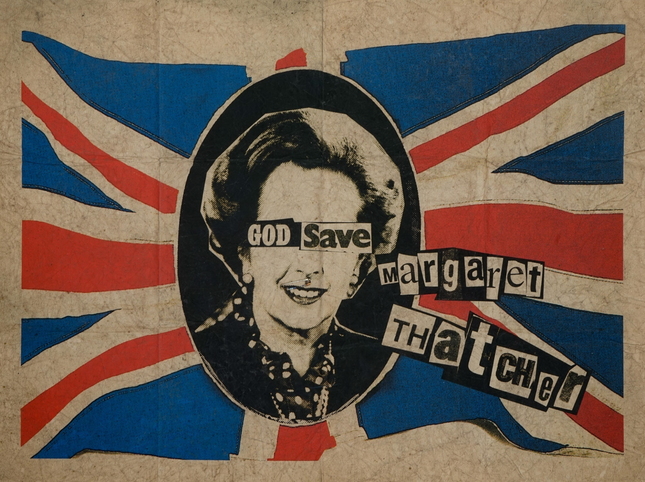
Government & Politics
-

God Save Margaret Thatchers Children by Billy Childish x Jamie Reid
God Save Margaret Thatcher Giclee Print Record CD Box Set by Billy Childish x Jamie Reid Artwork Limited Edition Print With Safety-pin On Distressed Fine Art Paper Graffiti Pop Street Artist. 2013 Signed & Numbered Limited Edition of 200 Artwork Size 27.6x20.5 2013 Thatcher's Children Boxed Record CD & Letter Box Set Plus L-13 Brown Bag The collaborative artwork "God Save Margaret Thatcher" by Billy Childish and Jamie Reid is a sharp and provocative commentary rendered through the lens of street pop art and graffiti artwork. The limited edition giclee print, part of a collection that includes a boxed record CD and letter box set, is a fusion of political narrative and artistic expression that captures the cultural zeitgeist of its time. Political Satire and Artistic Expression The giclee print is a bold statement within the pop art movement, a genre known for blurring the lines between high art and popular culture. Billy Childish and Jamie Reid, known for their aggressive aesthetics, use the iconography associated with Margaret Thatcher, the former Prime Minister of the UK, to create a layered discourse on power, policy, and patriotism. The artwork, sized 27.6x20.5 inches, employs the distressed look typical of street art and the precision of fine art printing techniques, with the addition of a safety pin that punctuates the piece with an emblem of punk culture. The image of Thatcher, presented with a stylized rendition of the Union Jack and the phrase "God Save," evokes the nationalistic fervor and divisive politics of her era. The choice of giclee printing ensures that each piece in the limited edition of 200 retains the vibrancy and detail of the original work, making it not just a political statement but also a collector's item. Reid and Childish's Distinctive Styles Jamie Reid, famously associated with the punk rock band the Sex Pistols, brings his characteristic ransom-note typography to the collaboration, complementing Childish's raw and expressive style. The layered text over Thatcher's image creates a visual cacophony that mirrors the social and political turbulence associated with her tenure as Prime Minister. The aesthetics of the print are reminiscent of Reid's work on album covers, while Childish's influence is evident in the vibrant and unrefined quality of the imagery. This limited edition print, signed and numbered by the artists, is a testament to their shared ethos of challenging authority and convention through art. The use of distressed fine art paper adds a layer of authenticity, emulating the ephemeral nature of street art and graffiti while simultaneously offering the permanence of fine art. Boxed Record CD and Letter Box Set Accompanying the giclee print is the "Thatcher's Children" boxed record CD and letter box set, an extension of the narrative explored in the print. This set, a combination of visual art and music, encapsulates the multifaceted approach to storytelling that both Childish and Reid employ. Including music and the written word with the optical components enriches the dialogue initiated by the print, offering a more immersive experience of the artwork's thematic content. Cultural Packaging: The L-13 Brown Bag The entire collection is presented in an L-13 brown bag, a packaging choice that is both practical and symbolic. The unassuming brown bag, often associated with the bland transportation of goods, is a vessel for transporting powerful artistic and political statements. The L-13 stamp on the bag indicates the involvement of the L-13 Light Industrial Workshop, known for supporting avant-garde and counter-culture artists, further aligning the collection with the spirit of rebellion and dissent. Significance in Modern Art The "God Save Margaret Thatcher" giclee print and accompanying items hold a significant place in the narrative of modern art. They represent a confluence of street art's accessibility, pop art's use of popular imagery, and the personal touch of graffiti art. The collection is not only a reflection of the political climate of the 1980s but also a timeless exploration of the power dynamics and societal structures that continue to shape contemporary discourse. Billy Childish and Jamie Reid's collaborative effort in creating the "God Save Margaret Thatcher" collection is a masterful blend of street pop art and graffiti artwork that resonates with cultural and political relevance. The print's limited edition nature, the giclee medium's quality, and the boxed set's comprehensive nature all contribute to the collection's appeal as a significant piece of art history and a poignant commentary on the social and political landscape.
$1,089.00 $926.00


